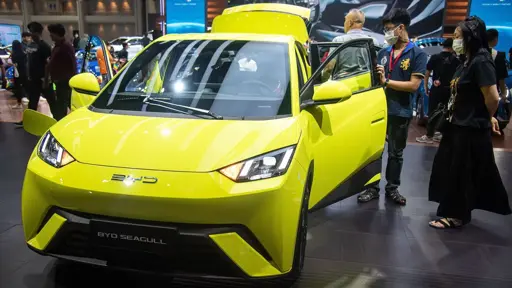Summary
China has become the world’s largest car exporter by dominating electric vehicle (EV) production, surpassing traditional carmakers in Europe, Japan, and the U.S.
This shift stems from China’s heavy investment in battery technology, supply chains, and generous subsidies, enabling it to produce cheaper EVs, like the BYD Seal, compared to Western competitors.
Europe and America, reliant on outdated internal combustion engine expertise, have struggled to adapt to this disruptive innovation.
Many nations are imposing tariffs on Chinese EVs, but without robust domestic battery infrastructure, Western car industries face mounting challenges as the EV transition accelerates.



It’s not (or at least not just) about subsidies, cheap Chinese labor, etc. It’s a fairly classic tech disruption story. Globally, the established carmakers know the future is electric, but they’ve got existing plants, workers who are trained to build ICEs, long established suppliers who make ICE parts, and so forth. You can argue that executives are being paid big bucks to solve such issues, which is true, but it’s truly a hard problem. Especially when these are real factories and workers and industrial equipment you’re dealing with.
But why did the disrupters come from China? Everyone is pointing to state support and existing strengths in battery tech, which are supply side factors, but there are also reasons on the demand side. Chinese people have relatively few cars (300 cars per capita, versus 850 per Capita in the US or 603 in the UK). As people get richer and start buying cars, there’s a chance for EV makers to get in the door. This, by the way, is why it makes sense that the Chinese EVs are entering on the cheap end of the market, whereas Tesla, which started out selling to western consumers, entered on the premium end.
China has its own ICE carmakers, but they aren’t established enough (and politically connected enough) to really push back against the onslaught of EV firms. (China can hardly impose tariffs on itself…) And at this point, the smarter ones like Geely have decided to go with the flow.
One other factor is that ICE engines are extremely complicated engines with many unique parts and established car manufacturers have perfected the technology over many generations. For comparison, electrical motors are a lot simpler engines, that are easier to manufacture and maintain. I read an article if VW switches entirely to EVs they still need to fire tens of thousands of employees as they won’t be needed to produce the same amount of cars.
This and the fact that a lot of the focus on the EVs is on the software and European car manufacturers are struggling immensely of building modern software to run their cars. This gives Tesla and Chinese EV manufacturers a big advantage.
Agreed, though the software part is a bit mystifying to me. It’s not like Europe doesn’t have good software engineers, so the fact that so many of Europe’s carmakers are having so many problems competing on software is jarring. It has to be some kind of institutional/cultural clash within these organizations.
I think the problem with software for European cars comes from the fact that so much of it is outsourced to so many suppliers (Bosch is one example). One supplier makes an HVAC module and the software for it. Another makes a braking system module, and the software for it. Another makes the drive train control modules, and the software for it. Then the car maker is required to build a car with all these disparate pieces and approaches with yet another outsourced company that makes the over all UX and UI software. Each company’s design philosophies, update mechanisms, and testing vary leading to a patchwork quilt of a final product. Yes a patchwork quilt will cover you, but upon usage and washing it will wear differently or fade.
VW specifically ran into just this problem. source
“To do that, the VW Group needed, for lack of a better term, a Tesla-like approach to software and digital technology. Historically for the entire auto industry, “software” means things like engine management, or driver-facing bits like infotainment and navigation, or numerous components made by different suppliers with different software standards who often didn’t talk to one another. It was piecemeal and old-school, compared to the smartphones and tablets that have become an integral part of our lives over the past two decades.”
Contrast this to the highly vertical approaches of many of the Chinese EV companies or Tesla. These companies build nearly all of their own modules (or at least contract manufacture them) then wrote all their own software for stitching the car together into one experience. There is one software update team. There is one team responsible for the bus and communications standards and protocols. If a team handling the HVAC needs to capture heat from the electric motor team (for energy efficiency and motor performance), these teams are in the same building or at least in the same company.
For better or worse, its cars built like software instead of parts from various disparate manufacturers like one would building a PC.
China is also following the well-tread path of Japan and then Korea. Build up a cheap manufacturing base, move into more complex products, then eventually stand up heavy industry in automotive. But China’s experience with batteries through consumer electronics along with its natural abundance of rare earth minerals, alongside the general maturity of EV technology, positioned it well to take an electric automotive route where Japan and Korea previously went ICE.
300 cars per person?